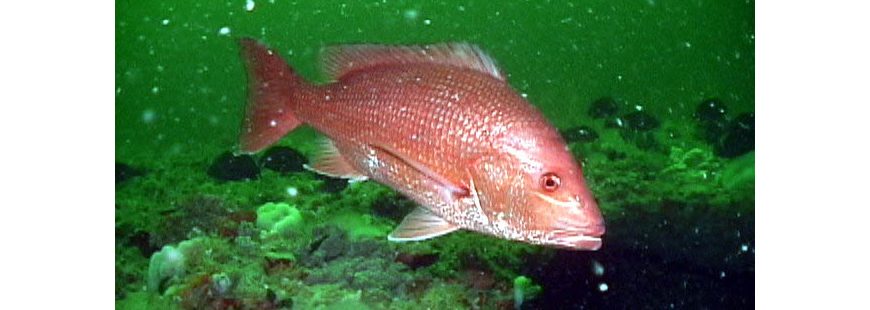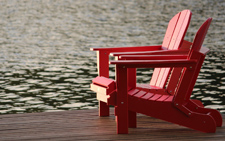Some words bring very clear pictures to mind.
In a fisheries context, the word ‘bycatch’ evokes images of industrial-scale commercial fisheries, where miles-long pelagic longlines take an unintended toll of sharks, billfish, and even marine mammals, while factory trawlers sweep the ocean floor with vast nets that scoop up anything that happens to lie, crawl, or swim in front of their gaping maws.
But one image that doesn’t immediately come to most people’s minds is that of a recreational fisherman, using nothing more than a single hook and line, threatening the health of a fish population by accidentally catching and killing too many members of an overfished stock.
Yet that scenario can occur, and it’s happening right now off the southeastern coast of the United States, where anglers targeting grouper and other reef fish are causing real, if unintended harm to the red snapper stock.
The South Atlantic stock of red snapper has been overfished for quite a long time. Stock assessments completed in 2009, 2010, 2017, and 2021 have all found the stock to be overfished and experiencing overfishing. The South Atlantic Fishery Management Council (Council) has put a rebuilding plan in place, and it appears that the stock is currently on track to rebuild by the 2044 rebuilding deadline. To achieve such rebuilding, the National Marine Fisheries Service (NMFS) established a 2024 annual catch limit (ACL) of 85,268 pounds for the commercial fishery, along with a commercial limit of just 75 pounds (gutted weight) of red snapper per trip, and a recreational ACL of 21,167 fish, paired with a recreational bag limit of one fish, of any size, per day.
To keep commercial landings within the commercial ACL, the National Marine Fisheries Service (NMFS) monitors such landings, and if they exceed, or appear likely to exceed, the commercial ACL, the commercial fishing season is closed for the rest of the year.
To keep recreational landings within the recreational ACL, NMFS establishes a recreational fishing season that it believes will be short enough to prevent an overage. In 2024, the recreational red snapper season in the South Atlantic region lasted for only one day.
However, seasons and ACLs only dictate when fishermen may keep red snapper; they have little impact on when red snapper can be incidentally caught and unintentionally killed. It is those incidentally killed red snapper, most of which are killed by the recreational fishery, that are making it particularly difficult for the Council and NMFS to rebuild the South Atlantic red snapper stock. As the Council has noted:
Since initial implementation of the rebuilding plan, red snapper fishing has been limited by few days of recreational harvest allowed annually and a low annual catch limit (ACL) for the commercial sector with a season beginning each year in July until the ACL is met. These measures, combined with growing effort in the South Atlantic snapper grouper fishery, particularly from the recreational sector, have led to a drastic increase in the number of red snapper that must be released after being caught. The increase in releases has, in turn, led to an increase in the number of fish that die after being caught and released, despite efforts from management and fishermen to improve survival after release through best practices and use of descending devices. The number of dead red snapper far outnumbers fish removed from the population by harvest.
Large numbers of releases limit managers’ ability to prevent overfishing and reduce the number of fish that can be landed by the fishery. Overfishing occurs when the number of total removals exceeds the overfishing limit. If more of these removals occur from fish dying after release, fewer fish may be landed.
It is thus in the best interests of both the red snapper and red snapper fishermen to reduce the number of fish that die after release, so that red snapper mortality may be reduced at the same time that red snapper landings might be increased. However, that is a far easier thing to describe than to achieve.
The Council tried to rein in recreational red snapper bycatch in 2022, when it initiated Regulatory Amendment 35. The Decision Document for such amendment spelled out the problem the Council was facing when it printed comments made by the Council’s Scientific and Statistical Committee (SSC), which observed that
To significantly reduce discard mortality, reducing encounters and effort is paramount. Long-term management strategies need to focus on these reductions in order to enable greater harvest to occur…
In the short-term (for this regulatory amendment), the SSC recommends pursuing temporal/spatial reductions (possibly wave-based) in bottom fishing. Seasonal differences among regions within the South Atlantic should be considered when developing these regulations, if possible. The bulk of recreational discards of red snapper are occurring off the East Coast of Florida; thus, spatial closures may be most effective in this area… [formatting omitted]
What the SSC was, in essence, suggesting was that the Council implement closed seasons and/or closed areas for all bottom fish, in order to reduce anglers’ out-of-season encounters with, and so their bycatch and release mortality of, South Atlantic red snapper. Anglers quickly rejected the idea. The Council reported that ‘much of the [Snapper Grouper Advisory Panel] was opposed to giving up access to other species to potentially increase ability to retain red snapper.’
The Snapper Grouper Advisory Panel (AP) itself provided a statement that read:
For Regulatory Amendment 35, the AP was asked to provide suggestions to further reduce red snapper interactions while fishing for other species. The AP was asked to consider punitive actions that may include bottom fishing closures and altered or shut down seasons for other species in order to avoid red snapper interactions.
The AP presented opinions and suggestions in the best of faith. However, the overriding opinion and feeling of the AP is that red snapper are recovered. This is based on the collective on-the-water experience of the AP members. The AP overwhelmingly feels they were asked for suggestions to solve a problem that no longer exists.
The red snapper is highly abundant. The biomass of the species is largely assumed by the AP as recovered and sufficient in abundance and range to begin a pathway to more liberal regulation of the species.
After the AP proved unwilling to even consider the scientific advice, and instead stubbornly maintained a position that no additional management actions were needed to reduce recreational bycatch and release mortality, and after recreational fishing organizations also expressed strong opposition to such measures, it was probably not surprising that, in the end, the Council did not forward Regulatory Amendment 35 to NMFS for approval.
But that did not end the debate over recreational red snapper bycatch.
On May 15, 2024, Tilman Gray, a commercial fish buyer in Hatteras, North Carolina, and Slash Creek Waterworks, Inc., a commercial fishing operation also located in Hatteras, brought a lawsuit against the Secretary of Commerce and the National Marine Fisheries Service, challenging ‘the failures of Defendants Gina M. Raimondo, in her official capacity as Secretary of Commerce, and the National Marine Fisheries Service (‘NMFS’), to promulgate regulations to stop overfishing on the South Atlantic stock of red snapper, as required by the Magnuson-Stevens Fishery Conservation and Management Act, 16 U.S.C. 1801-1891d…’
The complaint in that suit noted that, on July 23, 2001, NMFS notified the Council that the South Atlantic stock of red snapper was both overfished and experiencing overfishing; that the Magnuson-Stevens Fishery Conservation and Management Act (Magnuson-Stevens) requires regional fishery management councils to develop plans to end overfishing within two years of such notification; and that if a regional fishery management council fails to take such action within two years, Magnuson-Stevens requires NMFS to promulgate regulations intended to achieve such goals within the following nine months.
The complaint then alleges that both the Council and NMFS failed to fulfil such statutory obligations, and that both Tilman Gray and Slash Creek Waterworks have been harmed as a result.
NMFS must have recognized the validity of the plaintiffs’ claims, for on August 22, 2024, the parties to the lawsuit entered into a settlement agreement, in which the defendants agreed, among other things, to ‘complete and submit to the Office of the Federal Register for publication by June 6, 2025, a final rule implementing a Secretarial Amendment to stop overfishing on the South Atlantic red snapper stock under 16 U.S.C. [section] 1854(c) & (e).’
The defendants would be relieved of their obligation to file such Secretarial Amendment if, prior to the June 6, 2025 deadline, the Council has filed ‘a plan amendment or proposed regulations’ to end overfishing of South Atlantic red snapper, and defendants have submitted a final rule reflecting such Council’s action.
Thus, federal fishery managers are now being forced to address the issue of recreational bycatch, and the resultant discard mortality, in the South Atlantic red snapper fishery, whether or not the recreational interests who arguably dominate the Council wish to do so.
On September 20, 2024, NMFS notified the Council that it would be preparing the agreed-upon Secretarial Amendment, but has not yet said what such amendment would look like. However, in the notice published on its website, the agency stated:
The most recent scientific information indicates the South Atlantic red snapper stock is recovering consistent with rebuilding goals owing to higher than average recruitment of young fish in recent years, yet too many red snapper are being caught and discarded dead to sustain this recovery if recruitment decreases back to more historical levels. The magnitude of these dead discards is causing overfishing of the red snapper stock and preventing the more abundant, younger fish from surviving to the older ages necessary to sustain the population in the long term. Management measures that reduce dead discards may serve to both end overfishing of the stock and increase the number of red snapper that can be retained by fishermen.
NMFS’ focus on reducing dead discards both as a means to end overfishing and as a way to convert dead recreational discards into red snapper landings is very reminiscent of some of the language found in Regulatory Amendment 35, which was ultimately rejected by the Council. It would thus seem likely that the remedies considered in Regulatory Amendment 35, including the use of closed seasons and closed areas to reduce angling effort and anglers’ encounters with out-of-season red snapper, will be included in the final Secretarial Amendment.
But perhaps more importantly, the Secretarial Amendment may represent NMFS first effort to constrain bycatch-prone recreational fishing activities; in doing so, it would create an important precedent.


